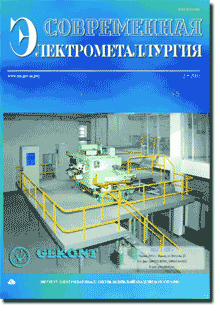

ELECTROSLAG TECHNOLOGY
Mitchell A. The prospects for large forgings of segregation-sensitive alloys 2
Problems of producing high-quality forging ingots from steels and alloys sensitive to segregation are considered. Fields of application, capabilities and limitations of VAR, ESR and ESHT are shown. Medovar L.B., Saenko V.Ya., Us V.I. and Yarosh V.M. Specifics in designing of bimetal billets for producing reinforcement bars with a corrosion-resistant cladding layer of steel 316L 8
Specifics in designing of bimetal billets intended for rolling reinforcement bars with a corrosion-resistant cladding layer made from low-carbon-austenitic steel of 316L type are considered. Using diagrams of A. Schaeffler, the expected structure of a corrosion-resistant layer of 350 mm diameter bimetal billet, subjected to cladding by a molten metal using the method of electroslag cladding with a liquid metal, depending on thickness of a cladding layer, depth of penetration and chemical composition of a base layer, was estimated.
Medovar L.B., Troyansky A.A., Saenko V.Ya., Fedorovsky B.B., Tsykulenko A.K., Ryabtsev A.D., Us V.I., Zhuravel V.M., ZajtsevV.A. and Petrenko V.L. About new approach to designing of ESR chamber furnaces 13
Problems of reconstruction of standard ESR furnaces to improve the economic efficiency and quality of metal are considered. Data are given about conception and design of the new chamber ESR furnace of the ALD Company.
Shapovalov V.A., Biktagirov F.K., Gnatushenko A.V. and Ignatov A.P. Problems of recycling of non-compact aluminium waste (Review) 15
Expediency of use of waste of aluminium and its alloys in production is shown. The most widely spread methods of recycling and refining of these materials are considered. The application of methods of electroslag melting and refining were suggested for these purposes.
Eryomin E.N. Application of electroslag remelting for regeneration of waste of heat-resistant alloys 20
Specifics of electroslag remelting of waste of heat-resistant alloys is considered. To improve the quality of ingots, a complex modifying of metal being remelted was suggested. Results of mechanical and metallographic investigations of cast metal are given. The advantages of the new technology and feasibility of regeneration of waste into cut-to-length charge billets are shown.
ELECTRON BEAM PROCESSES
Grechanyuk N.I., Osokin V.A., Grechanyuk I.N. and MinakovaR.V. Composite materials on base of copper and molybdenum, condensed from vapor phase, for electric contacts. Structure, properties, technology. Part 1. State-of-the-art and prospects of application of technology of electron beam high-rate evaporation-condensation for producing materials of electric contacts 24
The grounds are given for the selection of composition, structure and technology of producing the composite materials on base of Cu„Mo system using the method of electron beam high-rate evaporation-condensation. The peculiar features of the technological process and equipment for its realization are shown. Results of examination of structure of vapor-phase composite materials on copper and molybdenum base, their properties, comparative data about the behavior of materials of different origin (powdered and condensed) under the conditions of arc discharge action are given. Expediency of selection of vapor-phase composite materials was substantiated as an alternative of cermet materials with account for the experience in the development and application of powdered composite materials as electric contacts.
PLASMA-ARC TECHNOLOGY
Zhadkevich M.L., Shapovalov V.A., Torkhov G.F., Yakusha V.V. and Gnizdylo A.N. Drop transfer of metal in plasma-induction growing of tungsten flat single crystals 31
The process of metal transfer was studied in plasma-induction growing of profiled single crystals of tungsten. The effect of speed of plasmatron displacement and diameter of consumable rods on transfer properties was investigated. It is shown that the plasma-induction process of growing tungsten single crystals is characterized at their change in the range investigated by a coarse-drop metal transfer at a mass of transferred drops from 0.71 to 1.35 g on average.
Shapovalov V.A., Melnik G.A., Zhirov D.M., Zhdanovsky A.A., Tsykulenko K.A. and Prikhodko M.S. Application of plasma technologies in the processes of iron producing from ore materials 34
GENERAL PROBLEMS OF METALLURGY
Grytskiv Ya.P., Gaznyuk Yu.S., Nedelko M.S. and Krivko V.I. Modern possibilities of updating of analytical equipment for emission spectral analysis 41
Possibilities of updating and modification of emission photoelectric spectrometers of Leningrad Optical-Mechanical Works production are considered. Prospects of replacement of old electron recording devices by a controller of multi-channel photometric systems with a system of data computer processing are shown. Advantages of updated spectrometers and their features of operation using a software are demonstrated.
ENERGY AND RESOURCE SAVING
Petrov B.F., Kutuzov S.V., O.Yu. Urazlina and Bykovets V.V. Investigation of operation of electric calcinators at industrial enterprise of OJSC "Ukrainian Graphite" 45
Physical processes proceeding in an industrial furnace (electric calcinator), designed for producing a carbon graphite material with definite electric properties on the base of anthracites, are considered. Results of direct experimental investigations are given, the drawbacks of existing design of the furnace are described and its design changes are grounded.
ECONOMICS
Zhukov V.V. and Us I.V. About technical-commercial expediency of manufacture and application of bimetal reinforcement 50
Attempts were made to evaluate the efficiency of application of bimetal reinforcing steel in critical iron-concrete structures. It is shown that the efficiency of its application is connected with a reduction in number of repairs of iron-concrete constructions.
(You are viewing the simplified file contents)
